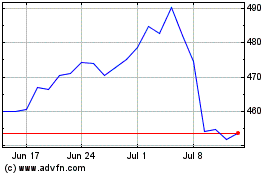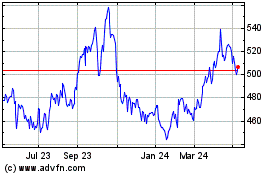BP Posts Fifth Straight Quarterly Loss -- 2nd Update
October 27 2020 - 8:51AM
Dow Jones News
By Sarah McFarlane
LONDON -- BP PLC reported a fifth consecutive quarterly loss on
Tuesday, providing the first glimpse of how major oil companies
navigated the third quarter amid a prolonged slump in demand
triggered by the coronavirus pandemic.
The loss follows one of the worst second quarters ever for the
sector, in which BP halved its dividend and cut jobs. In the third
quarter, oil prices stabilized at around $40 a barrel after diving
earlier in the year. Still, prices remain around a third below
where they were in the same period a year earlier.
BP's earnings also suffered from lower refining margins and
weaker trading results. Trading had provided a bright spot in the
previous quarterly earnings for BP, Royal Dutch Shell PLC and Total
SE, but lower volatility in the quarter ended Sept. 30 reduced
trading opportunities.
Other major oil companies are expected to report another weak
quarter, with Shell and Exxon Mobil Corp. having already flagged
expected losses in their oil-and-gas production businesses in
recent weeks.
Shell is due to report its earnings on Thursday, followed by
Chevron Corp. and Exxon on Friday.
Refining and trading sometimes offer some relief to major oil
companies during times of lower energy prices but recently even
these areas haven't been as profitable. Refining margins have in
the past risen when oil prices have fallen, but Covid-19's
decimation of fuel demand meant this didn't happen.
"Oil prices went down but refineries couldn't get the product
away to the market, people weren't flying, people weren't driving,"
said Murray Auchincloss, BP's chief financial officer, in an
interview.
BP said that the outlook for trading and refining margins
remained challenging due to Covid-19, with record-high inventories
and a leveling off in demand for gasoline and jet fuel.
The company reported a replacement cost loss -- a metric similar
to the net income figure that U.S. oil companies report -- of $644
million for the three months ended Sept. 30, from a loss of $351
million in the year-earlier period.
It is the first set of earnings for the British company since it
gave details of a wide-ranging revamp to become less dependent on
oil, while increasing investments in renewables and other
low-carbon energy sources over the next decade, at an event last
month.
That shift hasn't eased investor worry. The company's shares are
trading near a 25-year low and have underperformed their peers in
recent months.
"While the results were better than expected, they are still
extremely weak and it is far too early to anticipate a change in
market evaluation of BP's likely future performance under its
radical new strategy," said Colin Smith, an analyst at Panmure
Gordon.
BP's gearing -- the ratio of net debt to the total of net debt
and equity -- was in line with the previous quarter at 37.7%
including leases in the three months to Sept. 30. It remained above
the company's target of 20% to 30%.
The company's net debt fell slightly to $40.4 billion, from
$40.9 billion at the end of June.
When BP halved its dividend in August, the company said that it
would return at least 60% of surplus cash as share buybacks once
debt is below $35 billion.
"I would expect we'll move into buyback territory somewhere
around 4Q 2021, 1Q 2022," said BP's Mr. Auchincloss, adding this
was based on a Brent oil price of $45 to $50 a barrel.
The company plans to sell $25 billion of its assets by 2025 and
has already achieved around half of the target, including recent
sales of its Alaska business and its chemicals unit.
Net debt is expected to fall in the fourth quarter as proceeds
from the sales are received.
BP's shares traded down 0.1% on Tuesday.
Write to Sarah McFarlane at sarah.mcfarlane@wsj.com
(END) Dow Jones Newswires
October 27, 2020 08:36 ET (12:36 GMT)
Copyright (c) 2020 Dow Jones & Company, Inc.
Bp (LSE:BP.)
Historical Stock Chart
From Mar 2024 to Apr 2024

Bp (LSE:BP.)
Historical Stock Chart
From Apr 2023 to Apr 2024
